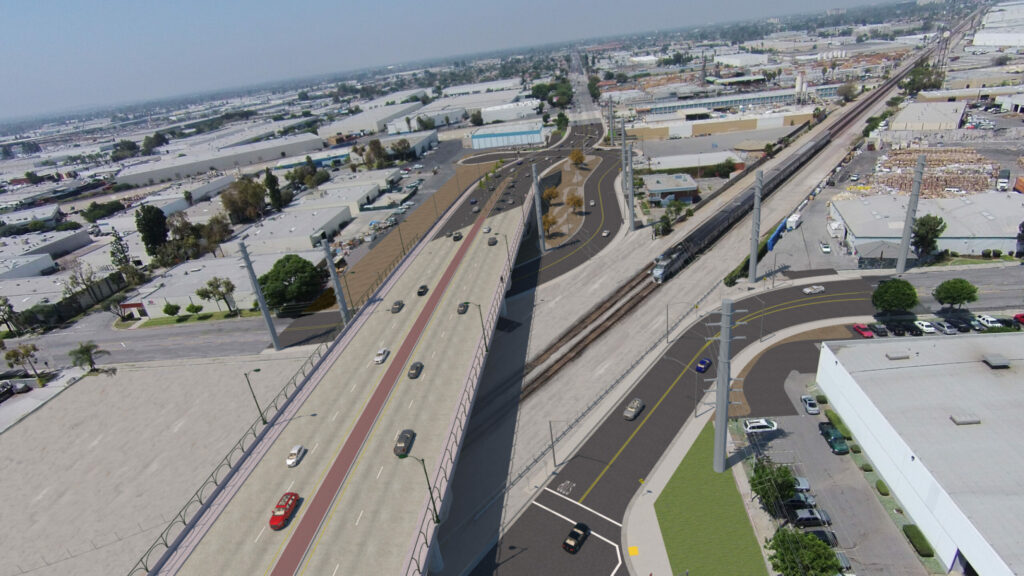
It’s officially the worst at-grade rail and road crossing in the state: a rail line cutting diagonally across a busy intersection in Santa Fe Springs in the midst of L.A. County’s industrial heartland.
An estimated 45,000 vehicles and 135 trains travel through the intersection of Rosecrans and Marquardt avenues in Santa Fe Springs each day – an average of one train crossing every seven minutes. As a result, vehicular traffic on both busy streets is brought to a standstill for a total of 21 hours per week.
Even worse, from 2013 to 2019, the California Public Utilities Commission recorded 31 rail-motor vehicle incidents at the intersection resulting in six fatalities and seven injuries – the most hazardous rail-motor intersection in the state.
But now, after more than a decade of effort, a fix is finally under way: a $156 million grade separation project that broke ground on June 2 and is expected to be completed in mid-2025. The project involves construction of a bridge for Rosecrans Avenue and a set of connector roads to allow vehicles traveling on Marquardt to get to the other side of the railroad tracks.
Flatiron Construction, a subsidiary of Essen, Germany-based construction giant Hochtief, is the general contractor on the project.
With vehicular and rail traffic separated, delays will be reduced overall, while the passenger and freight trains that jointly use the tracks should flow unimpeded.
“This project presents a win-win situation for our freight and transit partners,” Stephanie Wiggins, chief executive of the Los Angeles County Metropolitan Transportation Authority, or Metro, said in the groundbreaking announcement. “We know that time is money; therefore we must do all we can to ensure that our rail crossings are not an impediment to delivering people and freight safely to their destinations,” she added.
The rail line serves freight traffic for Fort Worth, Texas-based Burlington Northern Santa Fe (BNSF) Railway Co., as well as passenger rail service under the jurisdiction of the LOSSAN Rail Corridor Agency, which is a joint-powers authority formed in 1989 to increase ridership on the coastal rail line between San Diego, Los Angeles, and San Luis Obispo.
Much of the vehicular traffic that traverses Rosecrans and Marquardt avenues is tied to the logistics industry, moving goods to and from local warehouses and manufacturing plants.
A grade-separation project for the intersection was first proposed 20 years ago and Metro even cleared some environmental hurdles for the plan, which at the time was part of a larger set of rail improvement projects. But only a portion of the funding was secured, which resulted in work on other projects in the package beginning first.
Last decade, the railroad corridor was identified by the California High-Speed Rail Authority as a viable shared route alternative for the Los Angeles-to-Anaheim section of the proposed high-speed rail system, which jump-started the project again; the high-speed rail authority is now contributing half the funding for the project.
The grade-separation project calls for a bridge of roughly 580 feet in length to be constructed to allow Rosecrans Avenue to pass over the rail line – – simplifying the situation for vehicles on this heavily traveled road.
But vehicles traveling on Marquardt Avenue will face a somewhat more complicated and time-consuming set of maneuvers once the project is completed. Traffic will first be detoured onto a new connector road that will take it up to a signalized intersection with Rosecrans. The vehicles will then turn onto Rosecrans and traverse the bridge to another signal, where they will turn onto another new connector road to get back onto Marquardt. While somewhat of a time delay, it would still be quicker than waiting for a long freight train.
Metro spokesman Patrick Chandler said the idea of building a second bridge for Marquardt so the two streets would meet at an intersection above the rail tracks was rejected because of the additional right-of-way acquisition and utility relocation costs that would entail. Also, the connector roads maintain customer access for the businesses near the intersection.
